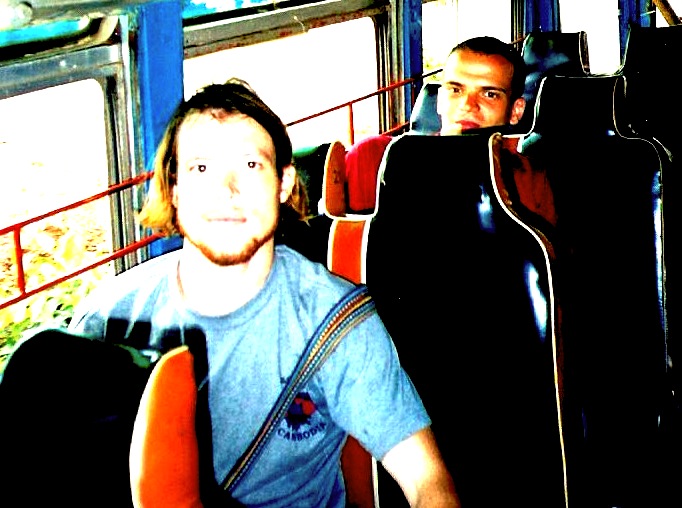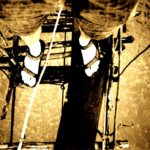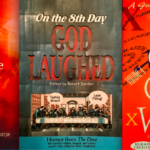Wandering off the Vietnamese budget travel trail in search of authenticity, our correspondent finds that authenticity isn’t all it’s cracked up to be.
By Rolf Potts
My last and perhaps most redemptive act as a tourist in the Vietnamese central highlands was to visit the Montagnard church in Kontum. There, perched innocuously on the back wall of the parish office, was a large painted-ceramic crucifix unlike any I had seen before.
Whereas most images of the crucifixion depict a Jesus agonized and exhausted by the pain of the world’s sins, the Montagnard Jesus looked downright chipper — his hair feathered back in the manner of a 1970s rock star, his mouth spread into a huge, toothy grin, his hands (which had somehow pulled loose from the crossbars) stretched out in a gesture of neighborly goodwill.
“Never mind the stigmata,” the Montagnard Jesus seemed to be saying. “Let’s have a barbecue!”
For devout believers, the notion of a Jesus so distracted and nonchalant in the face of his own crucifixion would seem a tad blasphemous. But for me — after a rather bewildering experience in the central highlands of Vietnam — the sight of Barbecue Jesus came as a kind of relief.
“Forget about your expectations,” Barbecue Jesus seemed to tell me. “Forget about what you think you’re supposed to do. Look at me. Run your hands over my ceramic finish and you’ll see: I am just as real as you are.”
* * *
My trip to the central highlands of Vietnam had started on a note of euphoric optimism on Route 13, around the same time half the people on my bus started vomiting.
Granted, watching a bunch of motion-sick Vietnamese farmers puke into plastic bags wasn’t all that pleasant, but I enjoyed the quirky feeling of otherness, as I was the only foreigner there. I was intrigued by the details of the experience: how the women dabbed a green salve under their nostrils to ward off the stench of gastric acid; how the men squatted on small plastic stools in the aisles to compensate for overcrowding; how everyone shared water from a grimy Mickey Mouse cup that floated in a jug at the driver’s feet; how the rounded corners and metal vent windows made our small bus look like an ice cream truck.
Route 13 is the main road through the central highlands, and I have since learned that it gained distinction as being the home of some of the heaviest fighting in the waning days of the Vietnam War. Portions of the road, which to this day are virtually impassable to anything bigger than a motorcycle, were once part of the Ho Chi Minh Trail supply route from the Laotian frontier.
In retrospect, the sole reason I had for traveling Vietnam Route 13 was because it wasn’t Vietnam Highway 1. The sole reason I was headed to the highland town of Kontum was because it wasn’t the highland town of Dalat. And the sole reason I wanted to travel a potentially dangerous stretch of the Ho Chi Minh Trail was because it wasn’t part of the Circuit.
In Southeast Asia, every country has a standard (though largely unspoken) Budget Travel Circuit. In Thailand, the Circuit involves any combination of southern islands and northern hill-tribe treks, with a few intermediary days in Bangkok. In Laos, the overland Circuit almost always includes stops in Luang Prabang, Vang Vieng and Vientiane. In Cambodia, no Circuit is complete without stops in Angkor Wat, Phnom Penh and Sihanoukville.
Vietnam’s Circuit roughly follows Highway 1 between Ho Chi Minh City and Hanoi. This largely coastal route features comfortable and convenient transportation, plentiful tourist facilities (from cheap motels to moped rentals) and sightseeing stop-offs from Haiphong to Hue to Hoi An. The problem with this, of course, is that so many travelers frequent this route that a person can go for weeks on the Circuit without having any legitimate interaction with the locals.
Perhaps no place illustrates this better than Nha Trang — a southern coastal city whose most famous citizen in backpacker circles is a small, visor-wearing woman named Mama Hahn. For about $7, Mama Hahn takes foreigners on all-day boat cruises that feature sightseeing, snorkeling, a nearly limitless supply of cheap beer and a floating lunch that features a man in a rowboat handing out marijuana cigarettes. Mama Hahn’s cruise has proven so popular with backpack travelers that she has already spawned a couple of imitators (one of whom, confusingly, also calls herself Mama Hahn).
I joined Mama Hahn’s boat trip one day after arriving in Nha Trang on the Circuit from Ho Chi Minh City. My seven Canadian boatmates (all of them friends, traveling together) were gregarious and funny — and the cruise through the bay was enjoyable enough — but I lost all sense of being in Asia within minutes of leaving the shore. It didn’t help that Mama Hanh carried a loudspeaker, and continually used it to squawk such non-traditional Vietnamese aphorisms as “Let’s party!” and “Who’s ready to get fucked up?”
As usually happens when travelers get together, the Canadians and I shared our road tales. Various members of the Canadian crew had been to places like Tibet, Goa, Samarkand and Tanzania. I hadn’t been to any of those places, but my Southeast Asian experiences seemed to meet with their approval. “I could tell when I met you that you were a seasoned traveler,” one of the Canucks confided at one point.
The thing is, sitting on Mama Hahn’s boat, I didn’t feel like a traveler at all — let alone a seasoned one. And — considering that my companions’ travel experiences seemed to center around sampling drugs in various far-flung corners of the earth — I began to wonder just what defined a “seasoned traveler.”
I came ashore from my Nha Trang boat excursion with a sunburn, a mid-afternoon hangover and the vague feeling that I could have experienced the exact same thing in Ontario.
Suddenly filled with the urge to do something different, I visited my guesthouse travel office and scanned the map, looking for a southern region that was as far from the Circuit as possible. I put my finger on an area near the Laotian border. “I want to go here,” I said to the Vietnamese woman who ran the office.
“That’s the central highlands,” she told me. “A very wonderful place. We can get you a ticket to Dalat for tomorrow.”
I knew plenty about Dalat. Dalat was a Niagra Falls-style highland resort town that boasted waterfalls, swan-shaped paddleboats on the local lake and a “minority village” that featured a giant concrete chicken. Dalat — on kitsch value alone — was already a part of the Circuit. “I don’t want to go to Dalat,” I told the tour woman. I tapped my finger on the northern stretch of Route 13. “What’s on this road?”
She thought for a moment. “Buon Ma Thot, Pleiku — but those places aren’t so interesting. Kontum is good. It’s like Dalat — lots of nature and hill tribes. But the road after Kontum is very bad. It’s only for motorcycles, or maybe army trucks. Nobody ever goes that way. Kontum is kind of a headache. I think Dalat is better.”
The next morning I went to the Nha Trang inter-city bus station and headed for Kontum.
It took me two days to get there — one day on a crowded, lumbering DeSoto bus bound for Buon Ma Thot, and one day on the ice cream truck vomitorium to Kontum. By the time I reached my destination, fresh air and legroom seemed like glorious, decadent luxuries.
After checking into a cheap hotel near the bus depot, I set off down the side streets of Kontum, hoping to find some place — such as a market — where I could mix in with the local folks. Not far from my hotel, I stopped to hold a storefront door open for a young man overloaded with boxes. A minute later, he came jogging up to me on the sidewalk and handed me a plastic sack filled with coffee beans.
“Is this for me?” I asked. At the time, I had temporarily forgotten that asking a yes/no question to someone who doesn’t understand English is possibly the most pinheaded mistake a traveler can make in Asia. Still smiling, the Vietnamese guy nodded.
I had no use for a big bag of coffee beans, but I was nonetheless touched by this seemingly generous gesture. Wanting to express my appreciation, I took out my Vietnamese phrase book and tried to make conversation. This proved to be a slow process, since spoken Vietnamese is a tonal language, and difficult for beginners. I mostly just communicated by pointing to words. It took me 15 minutes to establish that my friend’s name was Tran, he wasn’t married and his hobby was singing. I threw in a few personal bits about myself and showed him some pictures of my family.
As I made to end the conversation and leave, Tran seized the phrase book and flipped through the pages for a few moments. He stopped at the numbers page, pointed to “20” and looked at me quizzically.
“Twenty,” I told him. “That’s 20.”
“Twenty,” Tran repeated in English.
“Is that how old you are?” I asked, still oblivious to the yes/no rule.
Tran nodded. “Twenty,” he said. “OK!”
“Great,” I said. “I’m 28.”
“Twenty!”
I pointed to myself. “Twenty-eight.”
Tran pointed to the coffee beans. “Twenty!” he said.
I suddenly realized, after all this time spent endearing myself to Tran, that he’d never intended to give me the coffee. He’d merely been attempting to sell it to me. Figuring it a cheap enough way to save face, I took 20,000 dong (about $1.50) from my pocket and held it out to him. Tran scowled and pushed away the Vietnamese money. He dug into his pocket and pulled out a dollar bill. “Twenty!” he said.
I shook my head and handed the coffee back, but it was too late: Tran was convinced I wanted the coffee. By the time I gave up trying to say no and started to walk away, the price was down to $12. Tran pursued me, dropping the price to $10, then $8, where it hovered for a good 10 minutes as Tran backpedaled in front of me, waving the coffee in front of my face.
On paper, 10 minutes doesn’t seem like much, but when it’s spent trying to wave off an absurdly aggressive coffee salesman, 10 minutes is a maddening eternity. Finally, I broke. “No, Tran!” I yelled, coming to a halt on the sidewalk. “How many times do you want me to say it? No! No! No!”
Tran sneered and shoved the bag of coffee beans right up under my nose. Without thinking, I smacked it out of his hands. This sent Tran into a fury, screaming what I can only assume were the choicest of Vietnamese curses. I took it as my cue to leave when he spun around and kicked over a parked bicycle.
I never did find the market that night. I ended up weaving through the streets for upwards of an hour, trying to remember my way home.
It was after dark by the time I’d found my hotel. As I walked through the lobby, I noticed two little Vietnamese girls sitting on the couch, watching television. The older one looked to be about 6 years old, and the younger one couldn’t have been any older than 3. They were both clutching orange sodas.
“Hello!” the older one cried as I walked past.
“Hello,” I said. “How are you?”
“What is your name?” she replied.
“My name is Rolf. What is your name?”
“What is your name?” she said.
“I said my name is Rolf. But what’s your name?”
The girl gave me a confused look. “What is your name?” she said, a bit uncertain this time.
I squatted down by the couch and gave her a friendly smile. “We know my name. What’s your name?” I playfully wiggled my finger at her. Her face went blank. I pointed again. “Not my name,” I said brightly. “Your name!” The girl looked at me as if I’d just said I was going to hit her on the head with a hammer.
Worried about the direction our conversation was heading, I stood up and tried to look as cheery and non-threatening as possible. “Time for me to say goodnight!” I said. “Can you say goodnight?”
At this, the younger girl suddenly burst into tears.
I went to bed that night feeling like some kind of tragically misunderstood cartoon monster.
The following day I rented a clunky one-speed bicycle (a chore in itself; I won’t divulge how much I ended up paying for it), and rode out of the city in search of Montagnard ethnic minority villages. Following random roads out of town, I bicycled into a stunning landscape of river valleys, coffee plantations, huge white clouds and far-off purple mountains. The roads were lined with broad fields of maroon soil, smoking brick kilns, cement graves painted mustard yellow and mud-walled longhouses. In packed-dirt yards along the roadside, little girls coasted precariously on adult-sized bicycles while little boys ran around trying to urinate on each other. Tiny babies buzzed past on 100cc motorcycles, stoically perched on their fathers’ laps.
After about three hours of pedaling, I arrived at a rural minority village that looked suitably remote and authentic. I decided to stop and check things out.
In a way, I’ve always been a bit confused about the purpose of hill-tribe tourism, which has become a travel fad in places like Thailand and Vietnam. I guess the rural treks are meant to expose travelers to an exotic way of life and provide contrast to the modernized ways of places like Bangkok and Ho Chi Minh City — but I suspect that such treks largely serve to validate the sentimental standard of foreign exoticism set by National Geographic magazine.
My most immediate challenge upon arriving in the small village was simply trying to figure out what to do. In my mind’s eye, I envisioned a grand entry into the minority village, replete with tribal dancing, pigs butchered in my honor and a hearty round of toasts with some ill-tasting fermented beverage. In reality, I found the town largely deserted at midday. The few dark-skinned locals I did see were wearing western clothes (with occasional ethnic flourishes, such as a woven sash or a porkpie hat) and didn’t take much interest in me, even when I pulled out the phrase book and tried to make conversation.
After 20 or so awkward minutes of skulking around the village, I managed to insinuate myself into a group of teenaged boys, who were standing in a circle and kicking a chicken-feather birdie into the air. My rusty soccer skills were good enough to keep up with the boys, and we’d just managed to get a good volley going when a boozy, toothless old man wheeled my bike up and indicated that he wanted me to get on it and leave. The boys shouted angrily at the old man; the old man pointed at me and shouted back.
Then, without warning, the tallest boy cuffed the old drunk on the side of the head. As the old man reeled backwards, a second boy pushed him to the ground. When he tried to stand up, the tall boy kicked him in the rump. The others jeered and laughed. When the old man had scampered away, the tall boy looked over at me, smiled and gave a thumbs-up.
Not comfortable with the notion that my new companions had just shown their hospitality by beating the bejesus out of the town drunk, I excused myself at the first opportunity and — after a few more halfhearted attempts at interaction with the locals — pedaled back to Kontum.
Independent travel is often an act of hope — an optimistic attempt to blur the line between cultures through somewhat random interactions. By my second night in Kontum, however, I felt more like an outsider than ever. I decided to make a play at salvaging my trip by moving on.
The next morning I managed to hire (again, at a price I will opt not to share) a battered green ’70s era Dodge van to take me to Phuoc Son along the Ho Chi Minh Trail portion of Route 13. The driver was a high-strung wheeler-dealer type, and by the time we left the blacktop at Dac Glei, he had managed to fill the remaining seats in the van with a motley assortment of Vietnamese farmers. Despite my protests, I ended up having to share the shotgun seat with a parcel-laden old woman. I noticed, with a bit of dread, that she was carrying a bottle of green salve.
Thirty minutes into our creep down a rutted stretch of the road, the driver brought us to a rough and sudden halt. An overloaded white transport truck had rolled over in the middle of the road and burst like a sausage, jettisoning torn bags of rice and smashed boxes of clothes in its wake. Our driver cursed and stubbornly honked his horn, but there was no way around it. Angrily, he threw the van into reverse and managed to get us mired in the gravelly mud on the side of the road. After several minutes of flooring the accelerator, he yelled at everyone to get out. The farmers made for the side of the road and began to take out their food, looking like they expected to be there for a while. The driver remained in the van, cursing and stomping on the accelerator.
At that moment, with the back wheels of the Dodge sending chunks of gravel thumping off into the trees, I suddenly realized that I had no good reason for being there. I had gone to a remote corner of Vietnam with no sense of the language or culture — with no host or guide or guidebook, and no specific ideas about what to find there. The decision that brought me there was not a savvy act of independent travel, but an insipid act of negation — a ritual of avoiding other travelers, as if this in itself was somehow significant.
Wearily resolved, I shouldered my pack and started walking back up the road. After an hour or so, I hitched a ride on a flatbed lorry and made it back to Kontum by late afternoon. Since no buses back down to the coast were available until the next day, I checked back into my hotel and went for an aimless walk that eventually landed me in the Montagnard church.
There I offered up my confusion to Barbecue Jesus.
There is no such thing as a seasoned traveler, because travel is an ongoing experience of the unfamiliar. Regardless of how many stamps you have in your passport, you eventually find yourself in a place like Kontum, Vietnam, inadvertently making small children cry, hopelessly trying to deal with people who see you as nothing more than a consumer and haplessly walking in concentric circles until you can find something that resembles your hotel.
Sometimes, the Circuit is not a physical route, but a largely unavoidable state of mind that regulates your expectations. I had gone to the highlands looking for Vietnamese authenticity, but perhaps I was just looking for a generic affirmation experience — something superficial and positive to make me think I wasn’t just passing through like a ghost.
Ironically, the utter lack of affirmation and positive interaction I found was — in its own, frustrating way — bluntly authentic. All too often, the random workings of reality simply don’t match up with your reverent, idealized hopes.
Hanging there before me — strange, grinning, half-crucified — Barbecue Jesus seemed to understand.

This essay originally appeared in Salon.





